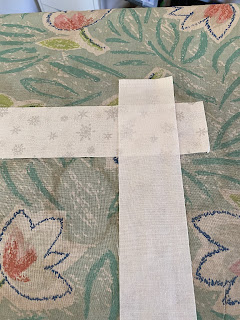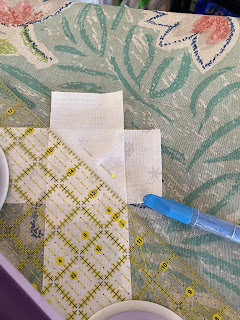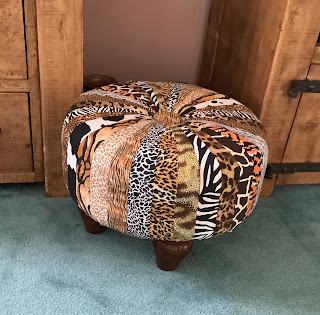But first the quilt needed to be trimmed from the excess batting and material not required. You can see from the photo below, I laid out the quilt on my table, with my rubber mat underneath and when I felt confident I had a straight line, I trimmed off the excess. A good way to make sure of a straight line is to line the ruler up against the middle border strip, checking the ruler line for that strip runs straight with the line on the ruler, small tweaks tend to be enough to then feel confident to go ahead and cut off the excess material to the edge of the quilt.
I checked my fabric stash to see what material I would go for to finish this quilt.
Then I proceeded to cut 2.5” strips
To make your binding continuous, you need to lay the strips right sides together, as per the photo below.
Then fold the material so it looks like the above photo, you create a crease in the material which will be your sew line.
Fold the material back again and pin the material and with a fabric pen draw a line along the sew line. This will help you keep on track when sewing.
Now the strips are ready to be sewn together.
Using a couple of back stitches at both ends, sew along the sew line.
And once this is done, go back to the iron to press the seam open.
Next you need to fold the material in half and press with the iron.
Once this was complete, the binding was then ready to pin to the quilt.
Starting at the bottom of the quilt, I located the middle. Added a pin.
Then located 4” to the right and left of the center and added 2 further pins.
Leaving a 10” tail on my binding, I then started to pin my binding, raw edges together, starting from the left hand pin, pinned the material to the first corner. Took the quilt over to sewing machine, adding a couple of back stitches, stitched to the first corner less 1/4” and finished with a couple of back stitches. Took the quilt out and made a 45 degree turn on the material to create a mitre corner. Then pinned the quilt all the way down the side, again finishing 1/4” from the end. Repeated the same exercise until I reached the pin I added to the right of the bottom center pin. At this point, I finished the stitching with a couple of back stitches. I took the quilt out and created two 45 degree cut lines, to the right tail and the left tail, making sure they would connect and ran in the same direction and then turned the material right sides together and sewed the final seam together. Once that was in place, I then proceeded to stitch the binding from the right pin to the left pin to complete the attachment of the binding.
To complete the binding, I then proceeded to fold the binding over to the back side of the quilt. To create an invisible stitch, the best way to finish the attachment of the binding is to hand sew the binding.
I’m a complete novice to this, I searched on YouTube and came across the attached video that helped me finish the binding enormously.
https://youtu.be/fJvDOEFlJ4s
Here is the finished quilt.










































